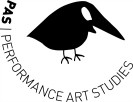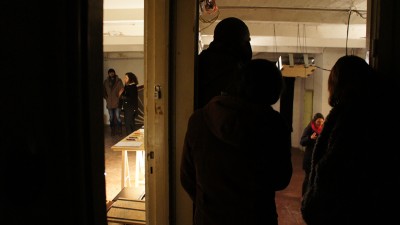A Rolling Stone Gathers No Moss:
About wander, research, doubt, the teacher and the learner
PRESENT TENSE SERIES IV 25. & 26.04.2014 19:00
with BBB Johannes Deimling
Curator Chiara Cartuccia
That wish to enter into an elusive element which had urged Cosimo into the trees, was still working now inside him unsatisfied, making him long for a more intimate link, a relationship which would bind him to each leaf and twig and feather and flutter.
Since late 1980s, German artist BBB Johannes Deimling has been working in the multifaceted field of performance art, elaborating a peculiar and very recognizable manner to treat this artistic non-medium. The performance art pieces of Deimling have been called agierte Bilder, literally “acted images”, making clear reference to the visual potential of his work. The performances Deimling ideated since the beginning of his long and fruitful artistic career are all characterized by a wise use of the material, a large attention to the visual impact, and an almost paradoxical limitation of gestures, echoed by his motto: “It is not the action that makes the performance”. BBB Johannes Deimling is also well known for being a performance art teacher, working in independent and public institutions; the topic of researching, learning and sharing is constantly at the bases of his artistic practice, and the visual performances cycle A Rolling Stone Gathers No Moss is not an exception.
The English proverb “A rolling stone gathers no moss” can have both a positive or a negative acceptation, on one hand being in a constant state of movement means to keep on evolving, changing without letting time impose its traces, on the other to be a perpetual wanderer implies do not have the capacity to settle down some necessary roots. BBB Johannes Deimling accepts both the meanings of this sentence, and sum-up them in a third option: to be involved in a constant movement does not mean to not have roots, rather to spread those roots everywhere. Becoming aware of the distance, as well as of the proximity with the objects of the world, the artist opens his practice to infinite possibilities, making his gestures an active part in the flux of the elements, and a vehicle of change.
In the performances composing this cycle Deimling creates visual moments that are connected one to the other by a system of subtle relations, which develop a composite collage of imaginative actions. The performance pieces are the sum of several figurative constructions, shaped by the interaction of artist’s movement with the objects, with their forms and colours, but also with their inner, symbolic meanings. BBB Johannes Deimling elects the metaphorical language of poetry as the favourite idiom of his performance practice: the objects that the artist chooses have the capacity to create a clear sense of beauty, while expressing, or suggesting, something more behind the simple optical gratification. Roses, soap bubbles, marbles and wooden chairs are some among the recurrent objects the artist uses in the series A Rolling Stone Gathers No Moss; all of these tools can encourage certain basilar feelings in the audience, if the rose suggests both beauty and ephemerality the chairs inspire stability and familiarity, to make an example. The physical intervention of the performer on the material, his interaction and play with his instruments, has the power to give a different form to the spontaneous sensations and interpretations of the spectators, overturning their perception of common elements from plain everyday life.
The performative actions of A Rolling Stone Gathers No Moss recall the concept of motion as change, as described by Aristotle in his Physics; the ancient Greek philosopher talks about movement as actuality of potentiality [1], stating that the essence of change, and its reason, is always to be found inside the element that changes. To explain this concept Aristotle uses two examples, the case of the teacher and the learner and the one of the clay and the pot. In the learner and the clay there is a full potentiality, translatable into actuality through engagement into movement, which means transformation. The teacher only stimulates a revolution that is already in the learner, as the clay has always contained the possibility of the pot.
BBB Johannes Deimling seems to embrace this same notion of inducement to movement/change, both when he works with objects, as in the case of his performative interventions, and when he interacts with his students. Deimling is aware that cannot be possible to define a clear distinction between the subject and the object of an action, the move and its result, the cause and the consequence, and there is no such thing as passivity in art or teaching.
[1] See Kosman, L. A., “Aristotle’s Definition of Motion”, in Phronesis, Vol. 14, No. 1 (1969), pp. 40-62
On Friday, April 25, within the frame of Present Tense Series, the performance art program of SAVVY Contemporary for 2014, BBB Johannes Deimling will present the 8th chapter of his performance cycle A Rolling Stone Gathers no Moss (2013-…), performing in collaboration with Lotte Kaiser (b.1999). During the same night the audience will get a chance to witness another performance piece, by Corentin JPM Leven (b.1993), one of BBB Johannes Deimling students from Norway Theatre Academy.
On Saturday, April 26, BBB Johannes Deimling will lead an artist talk on the topic teaching performance art, entitled “There’s no smoke without fire”.
BBB Johannes Deimling’s (1969 in Andernach, Germany) artistic practice encompasses performance art, action art, video, installation, drawing and music. Since 1988 Deimling has traded on everyday objects to create living images that would reflect a society full of contradictions, sentimentality, stupidity, creativity and cooperation. Searching for and finding ideas and suggestions in the banalities of daily life, Deimling transforms topics such as patience, will, war, religion or transportation into physical and poetic images. His ephemeral work has been on show in Europe, Israel, Canada, South America and Cuba, including the ICA in London, Kunsthalle Düsseldorf, Kiasma I museum for contemporary art in Helsinki, Center for contemporary art in Tel Aviv, Art Hall in Tallinn, Cornerhouse Gallery in Manchester, Neuer Berliner Kunstverein. Deimling participated in several international Performance Art Festivals, such as Interakcje in Poland, 7a11d in Canada, Bone in Switzerland, AccionMAD in Spain, Venice International Performance Art Week in Italy.
Since 1998, Deimling has been actively lecturing and teaching on performance art at various academic institutions, including the F+F, school for art and media design in Zürich, Switzerland; the Estonian Art Academy in Tallinn, Estonia; the Akademi for Szenekunst in Fredrikstad, Norway, and the TU Dresden in Germany. Since 2012, he is Associate Professor for Performance Art at NTA – Norwegian Theatre Academy at the Østfold University College. In 2008 he founded PAS-Performance Art Studies, a workshop project for international art students and young artists, hold in Canada, Germany, Israel, Serbia, France, Poland, Norway, Czech Republic, Lithuania, Cyprus, Netherlands and Estonia.
For more information please visit: bbbjohannesdeimling.de
Lotte Kaiser (b. 1999) discovered performance art during a PAS youth studies with BBB Johannes Deimling, later she matured a strong interest in this art form as an ideal tool for teenagers to express what is not expressible through words. Lotte has presented her works already in several art spaces, among others at Grimmuseum, Berlin. This is the first time Lotte performs together with BBB Johannes Deimling as part of the performance A Rolling Stone Gathers no Moss.
Corentin JPM Leven (b. 1993) is a student at the Norwegian Theatre Academy (NTA) in Fredrikstad, Norway, tutored by BBB Johannes Deimling. Corentin is currently studying scenography, and has a background in literature and philosophy. His work, as young performance artist, relates to the concepts of absurdity, kitsch and impossibility of expression.
Kindly supported by:



